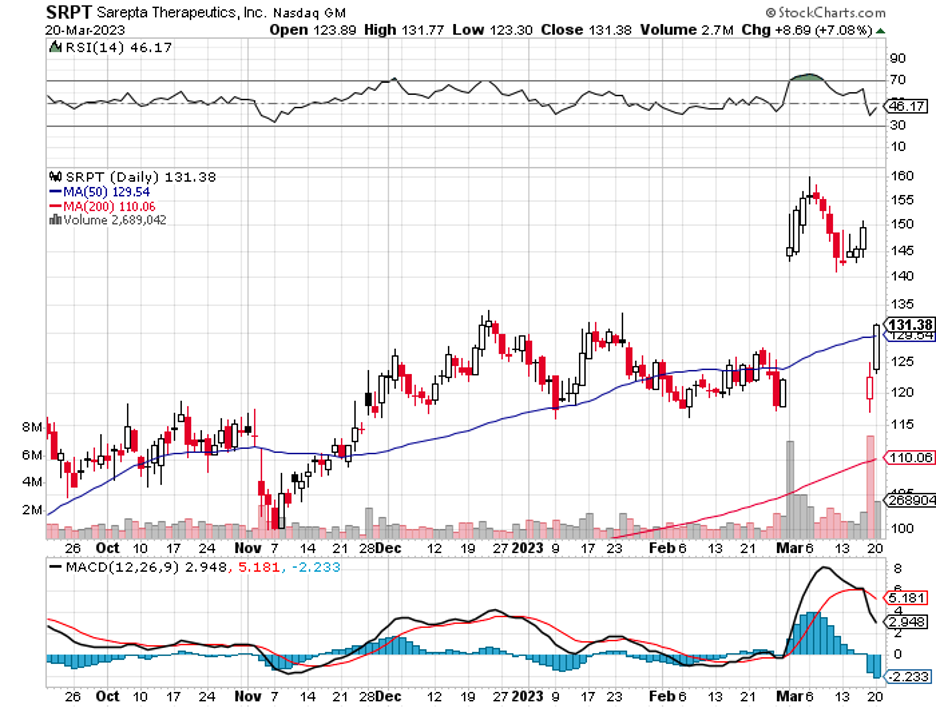Little Orphan Annie had already predicted it: “The sun will come out tomorrow.” While it is disheartening that we’re still in a bear market, stocks will bounce back eventually.
It looks like Wall Street overreacted once again following the change in leadership in the Food and Drug Administration earlier this month. Dr. Billy Dunn, the public face of the highly controversial accelerated approval granted to Biogen’s (BIIB) Alzheimer’s disease drug and the standard bearer of the organization’s push for more flexibility on drug approvals, retired.
Biotech investors have expressed anxiety over the possibility of facing more stringent rules in the drug approval process. The fear is that Dunn’s departure would signify a step toward a more conservative handling of applications.
While the FDA assured the public that the approval process would likely remain the same, some notable decisions are proving otherwise.
One of them involves Sarepta Therapeutics (SRPT).
Sarepta Therapeutics is a biopharmaceutical company that focuses on developing and commercializing RNA-targeted therapies for rare neuromuscular diseases. Founded in 1980, this Cambridge-based company’s most notable drug is Exondys 51 (eteplirsen), used to treat Duchenne muscular dystrophy (DMD), a rare genetic disorder affecting muscle function.
Exondys 51 is designed to skip over a faulty section of the dystrophin gene, which helps to produce a functional protein that can slow the progression of the disease. Sarepta is also developing RNA-targeted therapies for rare diseases, such as limb-girdle muscular dystrophy and myotonic dystrophy. Since then, the company has earned additional approvals for Vyondys 53 and Amondys 45.
Basically, Sarepta is to DMD as Vertex Pharmaceuticals (VRTX) is to cystic fibrosis—both have virtual monopolies in their target markets.
Recently, though, Sarepta stock has started to fall. This came after the FDA announced its plan to seek additional input from a panel of independent experts regarding the company’s new DMD gene-therapy candidate: SRP-9001.
The move came as a surprise since Sarepta disclosed only a week or so ago that the FDA had no intention to convene an advisory board to evaluate the candidate. However, since SRP-9001 is one of the first-ever gene therapies biologics license applications built on a surrogate perspective, meaning it’s an alternative to clinical results, the FDA felt the need to add a layer of review.
Still, the fall in Sarepta’s share prices appeared to be yet another overreaction. Besides, the move was not triggered by any issue with the candidate or data from the trials. It was simply a precautionary measure. Despite the slight detour, Sarepta remains optimistic that it will receive the go signal for SRP-9001 by May 2023.
Prior to this, Sarepta shares have been beating the market since 2023 started and have recorded more than double increases in the last five years. Although the company does not enjoy the same name recall as several of its peers, Sarepta’s platform of promising and innovative treatments has delivered critical wins in the past, especially in the DMD market.
On top of its DMD-centered products, Sarepta has over 40 clinical programs. That’s impressive for a biotech with an $11 billion market capitalization.
More importantly, the latest catalyst for Sarepta, SRP-9001, is projected to become another blockbuster. This Roche-partnered (RHHBY) treatment is estimated to generate more than $4 billion in peak sales.
Notably, this particular DMD indication has been shown to exhibit an extremely high barrier to entry, with practically all experimental treatments falling apart in clinical trials. Needless to say, SRP-9001 would have an exceedingly high commercial ceiling plus a built-in competitive moat.
Investors can expect remarkable progress from Sarepta as a company and its programs in the next five years. Given the company’s track record and history, it won’t be farfetched for it to come up with more blockbusters soon.



